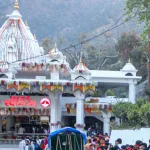BOOK REVIEW
With the month of April knocking at the doors of the Indian sub-continent, a perceptible change in weather conditions is in the air. The month brings in its wake the so called ‘advance rumblings’ of summer season in India with all its pluses and minuses lasting till the first showers of monsoon hits the ‘terra firma’ . The biggest minus being the acute scarcity of water in certain parts of India, despite the country being labeled as a tropical region gifted with an abundance of perennial rivers.
The severity or acuity of this water crisis that is a by word for the summer season in India is all the more pronounced in the western part of country i.e. Rajasthan; with Barmer district leading the pack of such districts.Water is the essence of life, an indispensible resource that sustains ecosystems, nourishes crops, and supports all life systems. Barmer will again be the front runner in bearing the brunt of this severity of water crisis this year,that has been its wont as far as human memory can recollect. But then there have been countless measures both governmental as well as Non- governmental who have been at the forefront of breaking the fall of this area into an abyss of perpetual water crisis, with some marvelous counter measures to boot.
‘Pipasa: A documentary on India’s water crisis in Barmer (Rajasthan)’ is a compelling and eye opening book that delves into one of India’s most critical environmental challenges—the water crisis in the arid region of Barmer, Rajasthan. Authored by a passionate environmentalist and investigative journalist RajKishor Mahapatra, this book offers an in-depth exploration of the multifaceted issues surrounding water scarcity in the region.
My impetus for penning this book review has been two fold—firstly having spent almost one year in this area (Munabao, Gadra road, Ramsar etc) during ‘OP Parakram’ while serving in the army, traversing each and every conceivable dhani (village) and witnessing first-hand trials and tribulations of the local populace with water crisis, its management, and how the lack of such a basic natural resource has dented the lives of these people for generations.
Secondly the hollow claims of previous dispensations including the present Modi Govt’s failure to reach out to the last dhani (house) of this arid region with its much proclaimed programme of ‘Harnal se jal’. Though the book was first published in July 2023, (almost 2 years back) yet no book is old enough to raise a most pressing problem of the country with such incisive precision as has been ‘Pipasa.
This painstaking job of making ‘Pipasa- A documentry on India’s water crisis in Barmer’ has a metaphorical air about it. The word ‘Pipasa’ in Hindi language means –‘acute thirst’ which Barmer connotes in its entirety and has been grappling with water shortage , famines and such like issues for centuries. At the other end of metaphorical connotation of ‘Pipasa’ is the acronym that stands for ‘Practical implementation of plans for the arid –sensitive area. What an apt connotation which encapsulates the area of Barmer with its most crippling issue till date, for which notangible solution has been found so far by anybody of reckoning.
Though the book is neatly divided into ten chapters with an excellent introduction delving into the critical issue of water scarcity in Indiawith a special focus on Barmer (Rajasthan); I have separated these ten chapters into three sections for the sake of this book review. I have clubbed the first three chapters viz ‘Rajasthan’s water challenges, understanding ‘Pipasa’ & ‘Unveiling of water crises under ‘Opening section’. The ‘middle section’takes into account chapters numbering four to seven laying stress on exclusive efforts in Barmer by way of various innovations in water conservation, collaborative efforts & policy interventions by myriad agencies including the governmental, NGOs & PPPs.
The sine quo non of this ‘middle section’ is the personal stories of struggle, survival and resilience that have been captured live by the author by going to various dhanis (villages/ houses) of Barmer district and recording their firsthand interviews on water crisis and how the absence of this natural resource has dented their generations both past and present in an irretrievable manner. This ‘middle section’ also contains the road ahead for the locals of Barmer with the all-pervasive importance of education in creating an ecosystem of overall urgency in water management for their survival. Topped up in this section are the ultimate lessons drawn from stories of inspiration across the world with similar / near similar terms of reference& woven into the overall tapestry of Barmer’s milieu.
As a reader flipsthrough the pages of this masterpiece book and delves into chapters eight to nine including the conclusion part under the ‘last section’; one discovers Pipasa’s impact on the locals of Barmer with the success rate in terms of ameliorating the water crisis, the challenges while implementing this unique effort as also lessons learnt all along the way. Moreover since the book gives a ‘thumbs up’ for the implementation of ‘Pipasa project’; the boots on ground for setting this project in the right direction and scaling up the same in other districts of Rajasthan grows much stronger .
Concluding this humongous work of Raj Kishor Mahapatra, the book lays stress on addressing India’s water crisis & the potential for collective action in a country which is factionalized on the lines of caste, creed and such like horrendous divides boding ill for one and all. Not only the book, on surfing the internet I was equally fascinated by one Dr Shiraz Sheikh founder of ‘Human welfare foundation’ an NGO who had been working tirelessly in the interiors of Barmer.
I was reminded of my visits to places like Ramsar bloc / Maroof ki basti and KKB / Khalif ki bawri which were traversed by me way back in 2001/02 as part of OP Parakram. I could instantly relate to the trials and tribulations of the women folk who used to spend major part of their lives lugging water in earthen pots on their frail shoulders or heads. Even at Munabao where I was deployed during OP Parakram for one year, a similar sad story existed. As part of ‘Civic action’ at the end of the operation I denoted two huge 1000 liters syntax tanks to primary school Munabao which I am sure would have been made good use of by the students over there.
But what I was not aware of was the fine research work done by Dr Shiraz Sheikh in cataloguing the fact that on an average , a Barmer woman spends 1400 hours and walks 4,000 kms in a year collecting water only for her domestic chores. But one discordant note in the entire narrative of this NGO-‘Human welfare foundation’ was the latest photos which were shared on the social media platforms of villages/dhanis of district Barmer; that looked taken straight from times about two and half decades back. I mean no visible improvement in the socio-economic milieu surrounding these hapless people of Barmer even after twenty years.
The readers of this article will be surprised to know that an NGO by the name ‘Ek plate Biryani’ functioning out of Canada too is at the forefront of ameliorating the water crisis of Thar desert people in Pakistan and has been doing a yeoman’s job without asking for any accolades. Though as per the JJM ( Jal Jevan Mission) of Rajasthan it has been claimed 3 years back that 3305 villages will be having six lakh seventy three thousand water connections spanning districts such as Barmer, Banswada, Alwar, Dholpur, Jodhpur etc, it remains to be seen how much has been done towards this end.
Since this master piece book by RaJKishor Mahapatra is of circa 2023, much has been disputed by the revered author in his book of the tall claims of the government in taking out the people of Barmer from this misery. This brings to the fore, author’sinvestigative journalism also; much to the discomfit of the authorities. This marvelous book is all of 118 pages, with both kindle version and paperback available to the readers priced at Rs 99 and 689 respectively on Amazon and similar e-commerce platforms.
The cover page of the book very poignantly depicts a small girl inside well filling water with a bucket to be roped up, signifying the adage—‘A picture is worth more than a thousand words.’ Last but not the least, the main USP of this book is a thorough research work backed up with a fantastic empirical data showing a mirror to those who proclaim to be champion of the ‘Sentinels of these sand dunes’.
Authored by a multifaceted personality who has an expertise in as diverse subjects as cyber security to digital content creator to an accomplished writer, a reader need to look no further for the stamp of approval of his findings which will go a long way in assuaging the border people of Barmer. A must buy book for those who need to know the remotest parts of this country and how the people survive there contrary to the tall claims emanating from the corridors of Raisina hills.
(The writer is a retired army officer and a regular scribe of Rising Kashmir. He can be approached on his [email protected])








